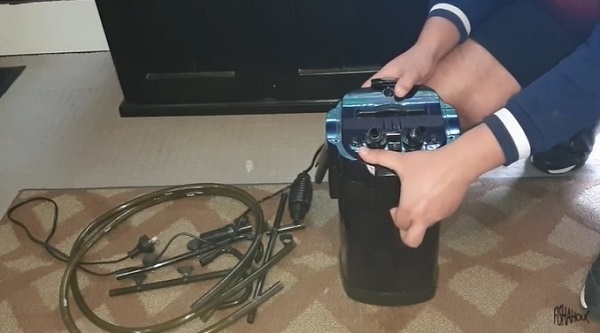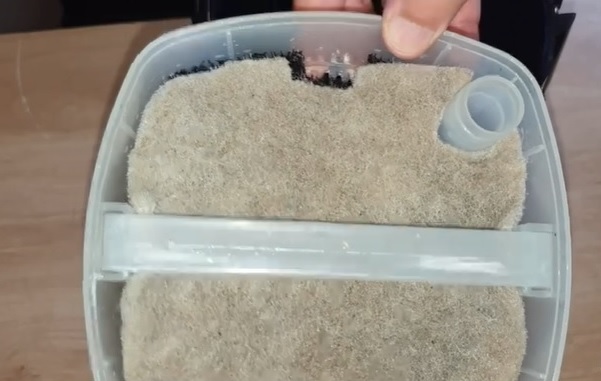How to Setup a Fry and Shrimp Safe Aquarium Canister Filter:
Canister filters draw water from the aquarium using an inlet tube. Water flows with high pressure through the filter baskets that contain heaps of mechanical & biological media, & then clean water is pumped back to the aquarium using a spray bar.
In this tutorial, I will explain how to setup a canister filter for my fish tank that avoids sucking fries & shrimps. Many filters have the problem of sucking fish babies & little invertebrates because they have a strainer at the intake valve that can easily suck fries. But tweaking a filter can make it safe for little fish. If you want to setup a canister filter that is safe for fries & shrimps, then cover your filter intake strainer with a sponge.
Add mechanical filter media to the first basket, & biological media to the second, third & fourth. Also, you can add chemical media. The best thing about canister filters is that it is highly customizable. So, you can choose the filter media that you want, & it holds heaps of media as compared to other filters. It is very easy to customize the media that you are adding to the canister filter.
How to setup filter media in a canister filter:
Take out the media from the canister filter baskets & thoroughly rinse it to wash impurities. Always wash the canister filter before using it because dirt can be accumulated both in the filter media & canister filter, & rinsing it will wash it. The filter media that comes with the canister filter is not cycled so it will take time to build good bacteria. It is possible to customize the canister filter & use your own media for better efficiency. In this project, I am also using some cycled media from my established aquarium that have accumulated heaps of beneficial bacteria.
Bottom:
I am using ceramic rings at the bottom to settle waste & stop it from swirling. Addition of ceramic rings will cover the void at the bottom of the filter. Ceramic rings will prevent the muck from clogging the mechanical filtration media.
First Basket:
The lowermost basket will contain three types of foams in the following order: coarse foam should be added to the bottom, followed by medium & fine foams. Canister filter draws water from the aquarium & an internal tube sends it to the bottom of the filter. Then water moves upward inside the canister filter & after passing through the mechanical & biological media, a pump pushes clean water back to the aquarium.
Coarse foam will stop all the big solid particles, & small particles will be able to pass through the coarse foam but it will be stopped by the medium & fine foams. Water free of fish waste / debris / dirt will enter biological filter media.
Second Basket:
Bio bakki balls are added to the second basket.
Bio bakki balls are heat treated with large surface area. Bio bakki balls are made of ceramic & they are heated at very high temperatures for long periods of time that break the internal bonds of the media & make a very porous surface that allow heaps of bio media to grow.
Rinse bio media before using it in a canister filter to wash all the dirt. Soak the media in aquarium water after washing it.
Third Basket:
Ceramic Rings are added to the third basket.
Ceramic rings provide a large surface area for the good bacteria. Good bacteria need a surface for colonization. If you offer more surface then more beneficial bacteria will grow. Ceramic rings have many tiny pores that provide a space for beneficial bacteria to grow.
Good bacteria break down toxic ammonia into nitrites which is less toxic than ammonia. Nitrites are further broken down into nitrates which is less toxic than nitrites.
Another advantage of ceramic rings is that it even consumes nitrates too. Bacteria that remove nitrates live in a place where oxygen is not available. They live inside porous materials.
I am using cycled ceramic rings from my established aquarium that already have accumulated good bacteria.
Fourth Basket:
Aqua One Premium Sub is added to the fourth basket.
Aqua One Premium Sub is an extremely porous sintered glass media that offers the perfect place for the growth of denitrifying bacteria that consume nitrates. Aqua One Premium Sub is very important for the healthy life of the fish.
Add Aquapro Booster Balls to every basket:
Aquapro booster balls add good bacteria. Add a few booster balls to every basket containing bio media.
Every ball contains lots of good bacteria & are inserted in a high nutrition liquid gel. After adding the ball to the filter, its coating is removed & good bacteria releases.
Close the canister filter basket tray:
Use a fine foam layer at the top before closing the basket tray. This will complete the filter media setup & now it is time to close the lid of the canister filter & lock it to stop water from leaking through the filter.
Close the filter lid & insert valve connector:
Close the canister filter lid & insert intake / outtake valve connector. Lock the filter to prevent water from leaking.
Water will flow from aquarium to the filter via an intake valve. Water will enter the filter from the top, & will reach the bottom of the filter using an internal tube. Water will then rise through the filter media to the top & it will be pumped back to the aquarium.
Assemble Filter Hose Connections:
Attach one hose to the filter intake & second to the outtake valve. Fill the canister filter with water from the aquarium.
Make sure you install the intake of the canister filter close to the tank heater & outtake to the opposite side of the fish tank. The positioning tip of inflow strainer & outflow spray bar will ensure that your tank water is circulated & will keep water at the same temperature.
Filter Outlet Hose Attachment:
Attach the canister filter outtake hose to the return connector & use a hose locking clamp to keep it secure. Attach a spray bar to the other end of the return connector to let water safely & quietly enter your aquarium. Use suction cups to attach the filter spray bar to the aquarium wall.
Filter Inlet Hose Attachment:
Fry & Shrimp Safe:
Attach a sponge to the filter strainer. Sponge will suck water from the aquarium & because sponge is a coarse foam so small particles of dust, fish waste, leftover food & other debris will also pass through the sponge but mechanical media inside the canister filter will stop it. Sponge will stop most of the debris that will otherwise clog the filter media but the downside is that you should clean the sponge frequently for efficient results.
Result:
After operating the filter for several minutes, I have checked both outflow & inflow, & have noticed amazing results.
Filter Outflow:
After operating the canister filter for some time, I have found that the water flow is decent & water is also circulating.
Filter Inflow:
I have noticed that the canister filter has efficiently collected debris in a short time that can be seen on the filter intake sponge.
Conclusion:
I have tested many filters & have found that canister filters are the best in cleaning because they hold heaps of media & a large volume of water flows through it. Canister filters could also come with UV lighting that can be used to wipe out harmful microbes in the water. Canister filters need regular maintenance & proper servicing in order to run quietly for a longer period of time.














Post a Comment